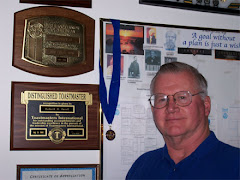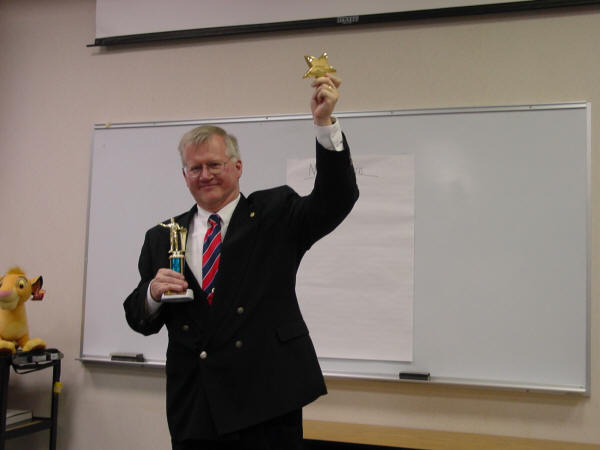Thursday, July 22, 2010
If they don't remember your opening you did "not" connect.
Several times over the last 5 years while evaluating an advanced speaker during a toastmasters club meeting I have asked the audience
"What was the speakers opening"? and have gotten no response.
I then would give them a memory jogger to see if they remembered,
what the opening was, still nothing.
The truth is the speakers opening was not memorable.
It did not connect with the audience.
So what makes a memorable opening? Is it Mr Chairman, fellow members, and friends (oh what a boring start (no connection, no excitement, blah, who cares)). What was the "Take Away Value" in that opening?
NOT MUCH.
I boils down to who is your audience? Are they engineers, doctors, lawyers,brick layers or a mixture? Some times you cannot tell. But normally your audience is made up of 3 types of people.
Auditory People - These are the type of people who learn by what they hear when they bring up memories it the sounds they remember first. They make up (25%) of your audience. The words that you might use in your opening and closing for these type of people are:
Hush, Ring, Utter, Tell, Shout, Scream, Clear - just to name a few.
These are the people who need you to TELL them what to do.
A sentence in your opening for these types of people might be.
Ladies and gentlemen give me your ear, the secret I'm about to tell you will change your life.
Visual People - These are the type of people who learn, believe, and process information that they can see. These people remember things in pictures. They make up (35%) of your audience.
These are the show me people. Some of the words you would use in your opening and closing statements for these type of people are:
Imagine, Visualize, Illustrate, Focus, Watch, Look, Picture.
A line in your opening for these types of people might be:
Imagine you are sitting at your desk when suddenly ___________.
These are the types of people like slides.
Kin aesthetic People - These are the people whom when they learn or bring up memories they remember how they felt.
These are the note takers.
These people make up (40%) of your audience. These people relate learning and remembering based on feelings, taste, touch, smell.
Words you might use in your opening are: Smell, Stir, Touch, Carry, Feel, Taste, Hot, Freezing.
Your possible opening sentence might be:
Get a load of this or Remember how it felt when_______________.
Close your eyes, you're in the kitchen of your favorite cook, you take a deep breath. You smell your favorite dish baking in the oven? The aroma floats tantalizingly under your nose. Your mouth begins to water!
Words you might use are: Smell, Stir, Touch, Carry, Feel, Taste, Hot.
When we speak to each other the percentage of how we communicate is:
7% Words
38% Tonality
55% Body Language
That's 93% of our communications have nothing to do with the words
we say. It has more to do which the tone in which we said.
And our body posture, gestures, eye contact.
What I am saying is that our priority when writing/preparing a speech to impact the majority of our audience would be:
(K) Kin aesthetic first, (A) Auditory second, (V) Visual third.
Rodger Jones an authority on Leadership has this example;
This is an example of how you might use the K,A,V criteria when preparing your speech.
This is an important day! I walked (K) into your office this morning with a feeling (K) of anticipation, and as I sit in front of you now I am excited
(K) about the opportunities that exist for us to grasp (K) together. I am hearing (A) from all quarters, the needs your people are stating (A) - we know they need to hear (A) answers. Together we can paint a picture (V) for them of the future - develop a vision (V), so that they will be able to see a clear (V) way forward in the new organization.
I realize that during an average conversation most of us would not talk like the paragraph above, but it demonstrates my points. When you use this process when preparing you openings and closings you have a stronger chance of connecting with your audience.
After all it's the openings and closings our audience should remember. If they don't we did not connect and there is no "Take Away Value"?
If there is no take away value why should they listen to you at all??????
I am reading a great book on body language called:
The Power of Body Language
How to succeed in every business and social encounter
Written by: Tonya Reiman
Published by: Pocket Books (I bought it at Barnes & Noble)
Remember it's not just what you say, it's how you say it, and the body language you use when you say it.
In the coming weeks I will talk about the words in openings.
I'm Bob Freel and that's "What I've Learned".




